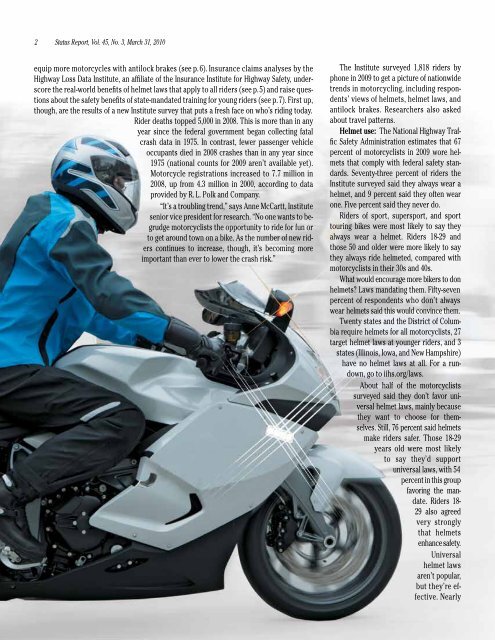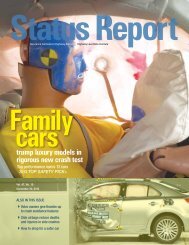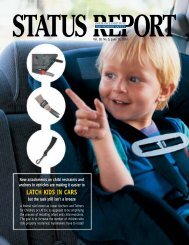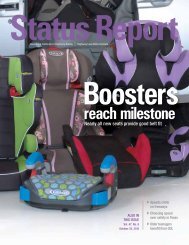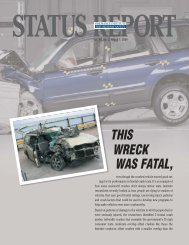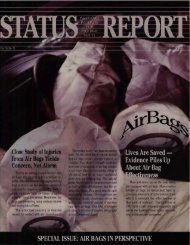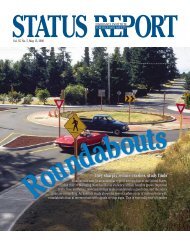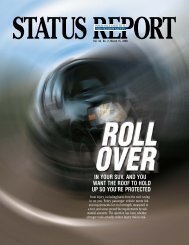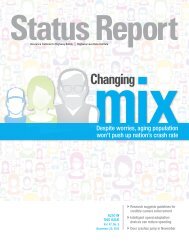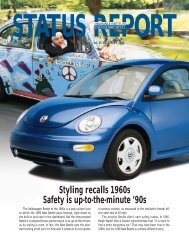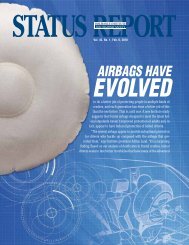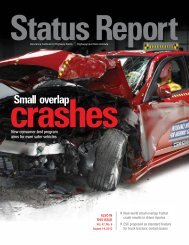IIHS Status Report, Vol. 45, No. 3, March 31, 2010 - Insurance ...
IIHS Status Report, Vol. 45, No. 3, March 31, 2010 - Insurance ...
IIHS Status Report, Vol. 45, No. 3, March 31, 2010 - Insurance ...
- No tags were found...
Create successful ePaper yourself
Turn your PDF publications into a flip-book with our unique Google optimized e-Paper software.
2 <strong>Status</strong> <strong>Report</strong>, <strong>Vol</strong>. <strong>45</strong>, <strong>No</strong>. 3, <strong>March</strong> <strong>31</strong>, <strong>2010</strong>equip more motorcycles with antilock brakes (see p. 6). <strong>Insurance</strong> claims analyses by theHighway Loss Data Institute, an affiliate of the <strong>Insurance</strong> Institute for Highway Safety, underscorethe real-world benefits of helmet laws that apply to all riders (see p. 5) and raise questionsabout the safety benefits of state-mandated training for young riders (see p. 7). First up,though, are the results of a new Institute survey that puts a fresh face on who’s riding today.Rider deaths topped 5,000 in 2008. This is more than in anyyear since the federal government began collecting fatalcrash data in 1975. In contrast, fewer passenger vehicleoccupants died in 2008 crashes than in any year since1975 (national counts for 2009 aren’t available yet).Motorcycle registrations increased to 7.7 million in2008, up from 4.3 million in 2000, according to dataprovided by R. L. Polk and Company.“It’s a troubling trend,” says Anne McCartt, Institutesenior vice president for research. “<strong>No</strong> one wants to begrudgemotorcyclists the opportunity to ride for fun orto get around town on a bike. As the number of new riderscontinues to increase, though, it’s becoming moreimportant than ever to lower the crash risk.”The Institute surveyed 1,818 riders byphone in 2009 to get a picture of nationwidetrends in motorcycling, including respondents’views of helmets, helmet laws, andantilock brakes. Researchers also askedabout travel patterns.Helmet use: The National Highway TrafficSafety Administration estimates that 67percent of motorcyclists in 2009 wore helmetsthat comply with federal safety standards.Seventy-three percent of riders theInstitute surveyed said they always wear ahelmet, and 9 percent said they often wearone. Five percent said they never do.Riders of sport, supersport, and sporttouring bikes were most likely to say theyalways wear a helmet. Riders 18-29 andthose 50 and older were more likely to saythey always ride helmeted, compared withmotorcyclists in their 30s and 40s.What would encourage more bikers to donhelmets? Laws mandating them. Fifty-sevenpercent of respondents who don’t alwayswear helmets said this would convince them.Twenty states and the District of Columbiarequire helmets for all motorcyclists, 27target helmet laws at younger riders, and 3states (Illinois, Iowa, and New Hampshire)have no helmet laws at all. For a rundown,go to iihs.org/laws.About half of the motorcyclistssurveyed said they don’t favor universalhelmet laws, mainly becausethey want to choose for themselves.Still, 76 percent said helmetsmake riders safer. Those 18-29years old were most likelyto say they’d supportuniversal laws, with 54percent in this groupfavoring the mandate.Riders 18-29 also agreedvery stronglythat helmetsenhance safety.Universalhelmet lawsaren’t popular,but they’re effective.Nearly


